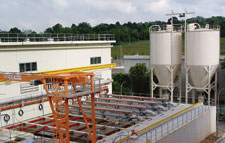 |
| Proven. Singapores $100-million, 72-mgd submerged-membrane plant was the first of its type. (Photo courtesy of Black & Veatch) |
A Southern California water utilitys $3.2-billion capital improvement project includes what will be the nations largest submerged-membrane water treatment plant. San Diego County Water Authority last month awarded CH2M Hill Constructors Inc., Denver, a $159-million design-build-operate contract for a 100-million-gallon-per-day plant in Twin Oaks Valley, north of San Marcos, Calif. Completion is scheduled for spring 2008.
Fine screening will eliminate large particulates before 14 separate 7-mgd submerged-membrane plants force water at a flux rate of 20 to 32 gallons per sq ft of membrane surface per day through pores ranging from .04 to .1 micron. This will screen out giardia, cryptosporidium and other organisms, which can range from 2 to 10 microns. "The combination of processes was designed to meet the water quality characteristics," says Bob Chapman, CH2M Hill project director.
The parallel array will permit regular backwashing of individual trains without disrupting treatment because water can be diverted to other channels. Peroxide ozonation and oxidation will disinfect and provide taste and odor control. Biological filtration through deep bed granular activated carbon and a pass through a liquid-chlorine mix chamber will provide secondary screening and disinfection.
A 72-mgd submerged-membrane water treatment plant is in operation in Singapore and, in 2006, the Regional Municipality of Peel in Toronto will commission a 95-mgd plant. Both use different pre and post-treatment systems because of unique temperature and water quality conditions.
CH2M Hills proposal costs $7 million less than the second-low bidders conventional treatment using coagulants to create floc clumps that settle or are
filtered out, says Jennifer Nakayama, SDCWA assistant project manager. The membrane option allowed for a smaller footprint, less concrete and fewer chemicals to store and use than traditional treatment methods, adds Chapman.
The district also plans a seawater desalination plant and increased storage capacity to deliver another 41 million gallons per day of water.

Post a comment to this article
Report Abusive Comment